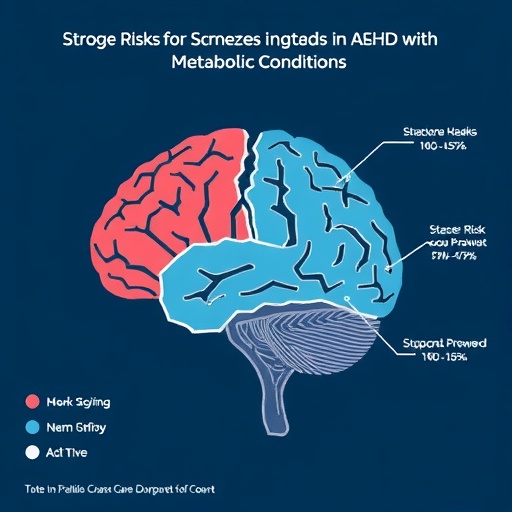Attention Deficit Hyperactivity Disorder (ADHD) has long been recognized for its impact on cognitive function and behavior, yet its broader implications on physical health, particularly cerebrovascular outcomes, are emerging areas of research. A groundbreaking retrospective cohort study recently published in BMC Psychiatry sheds light on the heightened risk of cerebrovascular diseases, specifically acute ischemic stroke (AIS) and transient ischemic attack (TIA), among adults with ADHD—especially in those burdened by metabolic conditions such as obesity, hypertension, and dyslipidemia.
This comprehensive study utilized the expansive Disease Analyzer database provided by IQVIA, allowing for an extensive 10-year retrospective analysis. By comparing 8,943 adults diagnosed with ADHD to a control cohort of 44,660 individuals without ADHD, the researchers meticulously applied propensity score matching. This statistical approach ensured a robust comparison by aligning cases and controls on key confounding variables, hence elevating the reliability of the observed associations between ADHD, metabolic comorbidities, and cerebrovascular events.
One of the striking findings from this retrospective analysis was the significantly increased incidence of acute ischemic stroke or transient ischemic attacks in the ADHD cohort compared to controls. Specifically, 1.7% of ADHD patients experienced these cerebrovascular events compared to only 1.2% in the non-ADHD group. Such a difference, though seemingly modest at face value, translates into a substantial public health concern when considering the widespread prevalence of ADHD, signaling a critical intersection between psychiatric and cardiovascular health that demands further clinical attention.
Delving deeper, the study identified that the risk was not uniformly distributed across all ADHD patients but was markedly accentuated in individuals older than 45 years. This age-related stratification revealed a hazard ratio of 2.34, signifying more than double the risk of cerebrovascular incidents in this subgroup relative to their non-ADHD counterparts. Such findings underscore the importance of age as a decisive factor modulating cerebrovascular risk profiles in ADHD populations, potentially attributable to age-related vascular changes compounded by ADHD pathophysiology.
Furthermore, metabolic comorbidities emerged as potent amplifiers of cerebrovascular risk in patients with ADHD. For those with obesity, the hazard ratio for developing AIS or TIA stood at 1.86, highlighting a nearly twofold increased risk that aligns with well-established vasculopathic effects of excessive adiposity. Hypertension among ADHD patients pushed this risk even higher, with a hazard ratio of 2.18, a finding that echoes the known deleterious impact of elevated blood pressure on cerebral vasculature integrity.
Arguably, the most dramatic elevation in cerebrovascular risk was observed in ADHD patients who also suffered from dyslipidemia. This subgroup exhibited a hazard ratio of 2.89, demonstrating an almost threefold increase in the likelihood of stroke or TIA events. Dyslipidemia, known for its role in atherosclerotic plaque formation and vascular inflammation, appears to synergize with ADHD-related factors in fostering an environment conducive to cerebrovascular compromise.
The researchers employed Kaplan-Meier survival analyses and univariable conditional Cox regression models to quantify these associations rigorously. By providing hazard ratios with 99% confidence intervals, the study ensured a stringent statistical threshold, lending further credibility to these provocative findings. The use of advanced epidemiological modeling techniques permits a clear temporal and causal inference, strengthening the argument that ADHD, especially when paired with metabolic abnormalities, precipitates heightened cerebrovascular vulnerability.
Clinicians and researchers have long debated the extent to which neurodevelopmental disorders such as ADHD influence systemic health beyond their classic behavioral symptoms. This study urgently reframes this discourse, demonstrating that ADHD’s footprint extends into vascular biology, potentially via mechanisms such as chronic stress responses, autonomic dysregulation, or medication effects. Importantly, the study calls for intensified investigation into these underlying pathways to better understand how ADHD may instigate or exacerbate vascular pathology.
The implications for patient management are substantial. Adults with ADHD, particularly those above middle age or suffering from metabolic syndromes, should be regarded as a high-risk group for cerebrovascular incidents. Preventive strategies, including aggressive management of obesity, blood pressure, and lipid abnormalities, may be warranted in this population. Furthermore, these findings advocate for multidisciplinary healthcare approaches integrating psychiatric care with cardiovascular risk assessment and mitigation.
Another intriguing avenue for future research lies in exploring the role of ADHD pharmacotherapy in modulating cerebrovascular risk. Stimulant and non-stimulant medications have distinct cardiovascular profiles, and their impact on long-term vascular outcomes remains incompletely elucidated. Understanding whether ADHD treatments attenuate or exacerbate cerebrovascular risk will be crucial in optimizing personalized therapeutic regimens that balance psychiatric control with vascular safety.
This study’s retrospective design, while comprehensive, also calls for prospective investigations that can track cerebrovascular outcomes in ADHD cohorts while accounting for additional variables such as medication adherence, lifestyle factors, and genetic predispositions. Longitudinal studies incorporating neuroimaging and biomarker analysis will be instrumental in unraveling the complex pathophysiological pathways linking ADHD to cerebrovascular damage.
Moreover, public health frameworks need to incorporate these emerging insights to raise awareness among healthcare providers and patients about the latent cerebrovascular risks tied to ADHD and its metabolic comorbidities. Enhanced screening protocols and early intervention programs could mitigate the incidence of stroke and transient ischemic attacks in this vulnerable demographic, ultimately reducing morbidity and mortality.
In essence, this pioneering investigation spotlights a critical, yet underrecognized, dimension of ADHD-related morbidity—its contribution to cerebrovascular disease. By bridging psychiatric and vascular research paradigms, the study paves the way for holistic care models that address both brain and systemic vascular health, promising improved long-term outcomes for millions of adults battling ADHD worldwide.
Subject of Research: Cerebrovascular disease risk in adults with ADHD and metabolic comorbidities
Article Title: Cerebrovascular diseases in ADHD patients with metabolic comorbidities: a retrospective cohort study
Article References:
Krieg, S., Krieg, A. & Kostev, K. Cerebrovascular diseases in ADHD patients with metabolic comorbidities: a retrospective cohort study. BMC Psychiatry 25, 799 (2025). https://doi.org/10.1186/s12888-025-07246-9
Image Credits: AI Generated




